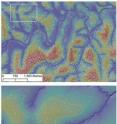Termites foretell climate change in Africa's savannas
Using sophisticated airborne imaging and structural analysis, scientists at the Carnegie Institution's Department of Global Ecology mapped more than 40,000 termite mounds over 192 square miles in the African savanna. They found that their size and distribution is linked to vegetation and landscape patterns associated with annual rainfall. The results reveal how the savanna terrain has evolved and show how termite mounds can be used to predict ecological shifts from climate change. The research is published in the September 7, 2010, advanced online edition of Nature Communications. Mound-building termites in the study area of Kruger National Park in South Africa tend to build their nests in areas that are not too wet, nor too dry, but are well drained, and on slopes of savanna hills above boundaries called seeplines. Seeplines form where water has flowed belowground through sandy, porous soil and backs up at areas rich in clay. Typically woody trees prefer the well-drained upslope side where the mounds tend to locate, while grasses dominate the wetter areas down slope.
"These relationships make the termite mounds excellent indicators of the geology, hydrology, and soil conditions," commented lead author Shaun Levick at Carnegie. "And those conditions affect what plants grow and thus the entire local ecosystem. We looked at the mound density, size, and location on the hills with respect to the vegetation patterns."
Most research into the ecology of these savannas has focused on the patterns of woody trees and shorter vegetation over larger, regional scales. Work at the smaller, hill-slope scales has, until now, been limited to 2-dimensional studies on specific hillsides. The Carnegie research was conducted by the Carnegie Airborne Observatory (CAO)–a unique airborne mapping system that operates much like a diagnostic medical scan. It can penetrate the canopy all the way to the soil level and probe about 40,000 acres per day. The CAO uses a waveform LiDAR system (light detection and ranging) that maps the 3-dimensional structure of vegetation and, in this case, termite mounds and combines that information with spectroscopic imaging—imaging that reveals chemical fingerprints of the species below. It renders the data in stunning 3-D maps.
"We looked at the vegetation and termite mound characteristics throughout enormous areas of African savanna in dry, intermediate, and wet zones," explained Levick. "We found that precipitation, along with elevation, hydrological, and soil conditions determine whether the area will be dominated by grasses or woody vegetation and the size and density of termite mounds."
The advantage of monitoring termite mounds in addition to vegetation is that mounds are so tightly coupled with soil and hydrological conditions that they make it easier to map the hill slope seeplines. Furthermore, vegetation cover varies a lot between wet and dry season, while the mounds are not subject to these fluctuations.
"By understanding the patterns of the vegetation and termite mounds over different moisture zones, we can project how the landscape might change with climate change," explained co-author Greg Asner at Carnegie. "Warming is expected to increase the variability of future precipitation in African savannas, so some areas will get more, while others get less rain. The predictions are that many regions of the savanna will become drier, which suggests more woody species will encroach on today's grasslands. These changes will depend on complex but predictable hydrological processes along hill slopes, which will correspond to pattern changes in the telltale termite mounds we see today from the air."
Source: Carnegie Institution
Other sources
- Termites foretell climate change in Africa's savannasfrom Science Daily14 years ago
- Termites foretell climate change in Africa's savannasfrom Physorg14 years ago


